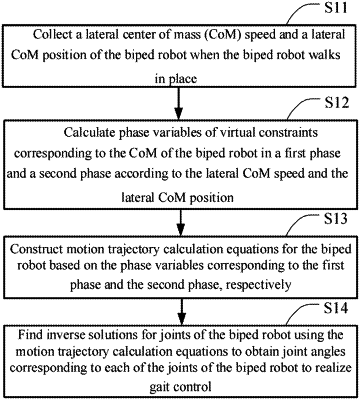| CPC B25J 9/163 (2013.01) [B25J 9/1664 (2013.01); B25J 13/088 (2013.01); B62D 57/032 (2013.01)] | 17 Claims |

|
1. A computer-implemented method for controlling gait of a biped robot, comprising:
collecting a lateral center of mass (CoM) speed and a lateral CoM position of the biped robot when the biped robot walks in place, wherein the lateral CoM speed is a speed of the CoM of the biped robot in a left-right oscillating direction, and the lateral CoM position is a position of the CoM of the biped robot in the left-right oscillating direction;
calculating phase variables of virtual constraints corresponding to the CoM of the biped robot in a first phase and a second phase according to the lateral CoM speed and the lateral CoM position, wherein the first phase represents a phase in which the CoM of the biped robot moves from a position farthest from a support leg of the biped robot to a closest position, and the second phase represents a phase in which the CoM of the biped robot moves from the closest position from the support leg to the position farthest from the support leg;
constructing motion trajectory calculation equations for the biped robot based on the phase variables corresponding to the first phase and the second phase, respectively; and
finding inverse solutions for joints of the biped robot using the motion trajectory calculation equations to obtain joint angles corresponding to each of the joints of the biped robot to realize gait control;
wherein calculating phase variables of virtual constraints corresponding to the CoM of the biped robot in the first phase and the second phase according to the lateral CoM speed and the lateral CoM position, comprises:
determining whether the lateral CoM speed is less than a threshold:
in response to the lateral CoM speed being less than the threshold, acquiring an initial speed of the CoM of the biped robot, and calculating a first phase variable corresponding to the first phase according to the initial speed and the lateral CoM speed;
in response to the lateral CoM speed not being less than the threshold, acquiring a step width of the biped robot and an initial position of the CoM, and calculating a second phase variable corresponding to the second phase according to the step width, the initial position and the lateral CoM position:
wherein calculating the second phase variable corresponding to the second phase according to the step width, the initial position and the lateral CoM position, comprises:
acquiring a desired speed of the CoM and an actual speed of the CoM of the biped robot at a termination moment of each step; and
calculating the second phase variable according to the step width, the initial position, the lateral CoM position, the desired speed of the CoM, and the actual speed of the CoM; and
wherein calculating the second phase variable according to the step width, the initial position, the lateral CoM position, the desired speed of the CoM, and the actual speed of the CoM, comprises:
calculating a speed feedback term according to the following equation:
 where
 represents the speed feedback term, kp represents a preset coefficient, yd represents the desired speed of the CoM, and represents the speed feedback term, kp represents a preset coefficient, yd represents the desired speed of the CoM, and  represents the actual speed of the CoM; and represents the actual speed of the CoM; andcalculating the second phase variable according to the following equation:
 where ϕ2 represents the second phase variable, D represents the step width, y represents the lateral CoM position, and yel represents the initial position.
|